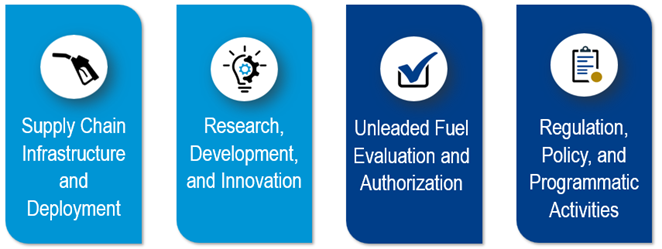Building an Unleaded Future by 2030
Eliminate Aviation Gasoline Lead Emissions (EAGLE)
The FAA and partners in the aviation community launched the EAGLE initiative as the result of a Congressionally mandated report from the National Academies. The EAGLE team’s goal is to eliminate leaded aviation fuels in piston-engine aircraft safely by the end of 2030.
To achieve the lead-free goal, EAGLE will:

- Identify at least one unleaded fuel acceptable for safe General Aviation fleet use.
- Minimize the safety and technical impacts associated with high-performance engines using unleaded fuels.
- Facilitate the increased production, distribution and greater use of unleaded replacement fuels.
- Ensure that 100 low-lead fuel is available during the transition to unleaded fuel.
- Establish policies that support airport infrastructure funding for unleaded fuel.
- Endorse plans that reduce or eliminate reliance upon leaded aviation fuels.
How We Will Get There


![]()
![]()


![]()
![]()

![]()
Progress Toward a Lead-Free Aviation System

- FAA has two pathways available to obtain FAA authorization for the use of a new unleaded fuel:
- FAA fleet authorization process established by Congress and in conjunction with the Piston Aviation Fuels Initiative (PAFI)
- Traditional FAA aircraft type certification / supplemental type certification (STC) process
- FAA and EAGLE have developed a chart to show various attributes of both pathways.
- Under the STC process, in September 2022, the FAA issued an expanded FAA approved model list STC to GAMI for a 100 octane unleaded fuel (G100UL) for general aviation aircraft. In September 2024, FAA issued Swift Fuels, an STC for Cessna 172R/S Skyhawks with Lycoming IO-360-L2A engines to operate on a high-octane unleaded fuel (100R).
- In March 2023, the FAA issued a Fleet Authorization Policy Statement. The Policy Statement describes the general process to obtain a fleet authorization of a qualified unleaded fuel candidate. The intent of the statement is to authorize qualified candidate unleaded fuels for safe use in applicable aircraft and engines for the U.S. piston-engine general aviation fleet.
- Under the Piston Aviation Fuels Initiative (PAFI), the FAA is currently working with the LyondellBasell/VP Racing team to test and evaluate its high-octane unleaded candidate fuel solution (UL 100E). The FAA expects to issue a fleet authorization for the higher-octane fuel after successful completion of PAFI full scale testing of the fuel candidate.
- To help provide guidance to flight schools, FAA and EAGLE have also developed a guidance document to help flight schools with their transition to a lead free future.
- The Airport Cooperative Research Program within the Transportation Research Board is collecting data and creating best practices focused on the safe transition to unleaded fuels for the country's fleet of 220,000 piston aircraft. The project nears completion and will result in a guidebook for airports in late 2025.
For further information regarding the EAGLE initiative, please visit flyeagle.org. The site is developed and maintained by the industry partners.
EAGLE Resources
The Piston Engine Aviation Fuels Initiative (PAFI) was established in 2014 to support the evaluation of candidate-unleaded fuels to replace approved leaded gasoline.
Resources
- Guidance on Transitioning a Flight School to Unleaded Avgas
- The National Academies Press, Options for Reducing Lead Emissions from Piston-Engine Aircraft
- Final report of the Unleaded AVGAS Transition Aviation Rulemaking Committee (UAT ARC) - Unleaded AVGAS Findings & Recommendations:
Other Information
Media Inquiries: Contact the FAA Press Office at pressoffice@faa.gov
